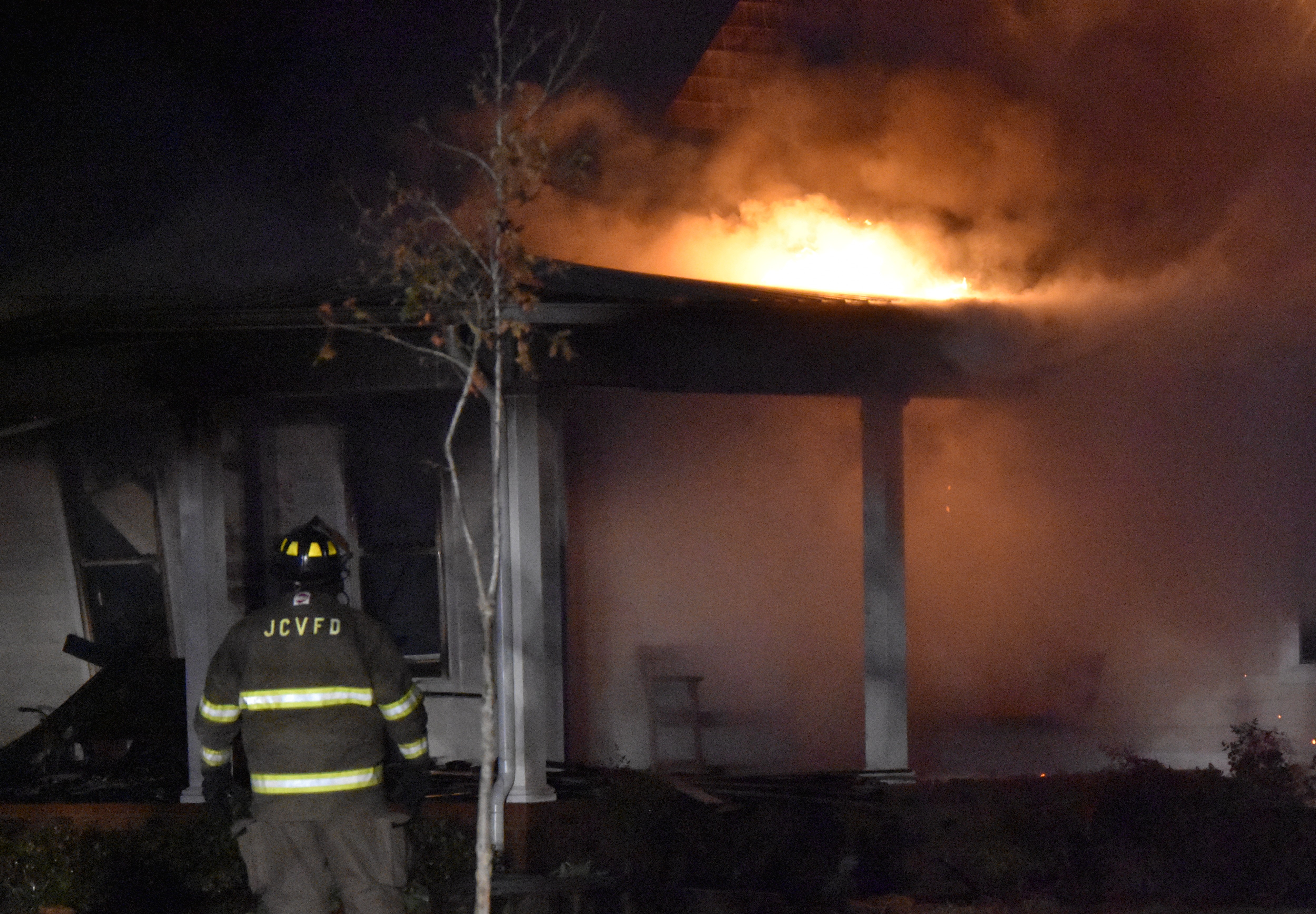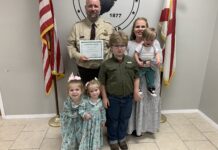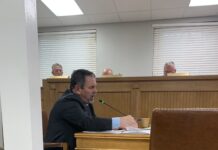A Johnson's Crossing volunteer firefighter on the scene of a house fire in White City in November 2018 (W.C. Mann for The Cullman Tribune)
CULLMAN COUNTY – When Hanceville Mayor Kenneth Nail sounded the proverbial alarm at Thursday night’s Hanceville City Council meeting about a serious shortage of volunteer firefighters, he wasn’t crying wolf by any stretch of the imagination. A study of national statistics shows that, over the last three decades, the number of volunteer firefighters has dropped by 12 percent nationwide, while calls for service to fire departments have increased by more than 200 percent. Even a 43 percent increase in paid firefighters over that period hasn’t kept up with the demand, and means nothing for the small volunteer departments that comprise 70 percent of the nation’s firefighting/emergency medical response force and protect approximately half of America’s citizens.
Nail told the Hanceville City Council, “This is a problem. The problem isn’t just in Hanceville. The problem is in Cullman County and in Alabama. We’ve got four full-time firefighters. We responded to 1,100 calls last year. We have five volunteers.
“In the last month, I have heard we were the fourth fire department toned out, and of course we responded. It is starting to be a public safety emergency. Especially the volunteers, these guys do the best they can, but most of them still have to go to work. We have five volunteers. Five! In the daytime, everybody fights fires-everybody. The police, fire, public works; everybody helps.”
Hanceville has already begun basic fire training for its police department, but with fewer people volunteering, Nail said the departments are struggling.
Shared Nail, “One of our fires yesterday, one of the firemen was on the scene by himself for a few minutes before the other guys got there. I’ve done it and (Councilman) Jim (Nuss) has too, rolled up and been the only guy there at a house fire for several minutes. It’s a long several minutes.
“I think we’re in a public safety emergency. I don’t know what the answer is. People don’t volunteer anymore. The volunteers we’ve got are wonderful. They are great, but it’s a serious, serious problem. You have a structure fire at the wrong time during the day, when other folks have gone to work, you’ve/we’ve got problems.”
A sampling of opinions from Cullman County volunteer fire chiefs around the county supports Nail’s concerns:
Logan Chief Toby Bates
“We really don’t have a situation necessarily in Logan. I’ve got probably 20 volunteers. But the problem, really, is the countywide. I mean, Logan could stand to use more volunteers, just like every department could, but in today’s time, there’s nobody volunteering anymore.
“You don’t get these young kids out of high school that are interested in volunteering. And that’s the people that needs to be volunteering, you know, the ones right out of high school, 18, 19 years old, because that’s the next generation of firefighters. And if we can’t get those people to start volunteering, all the older people that’s in the fire departments now, you know, I’m 44, but I can‘t keep doing this forever. But if there’s not nobody behind me coming up to sort of carry things along, you know, several years down the road, there ain’t going to be no fire departments.
“It’s not just a problem here; this is a problem all over the United States. Every state, every county has the same problem, that they’re just running into shortages of volunteers.”
Bates feels that some sort of per-call compensation would be needed to solve the problem in the long run.
“That’s about the only way I’m seeing that you can attain people, is by paying them, because people nowadays, they’ve got so much going on. Families and whatnot–you know, the husband and wife, sometimes they don’t have time. They can’t volunteer. They may want to volunteer but they can’t, because they might be having to work two jobs just to pay their bills or whatever. Then their kids got ball games or whatnot. And they just don’t have that time to volunteer.
“I know a lot of people right now that wants to volunteer, but they just ain’t got the time, between work and everything else, the time’s not there. And it’s getting worse and worse because, as the economy gets–you know, everything’s more pricey and everything’s higher and higher. People are having to work more to pay for everything.
“In the end, where it hurts is people in the fire service, for volunteers, because you don’t have those people who have time to come to calls, because they can’t do it.”
Bates also noted that many departments suffer from a lack of manpower during weekdays, when most people work.
“If you get a house fire in the middle of the day,” said Bates, “heck, everybody that’s in that fire department, they all may work day jobs and all them may be at work. So when you get in that situation and you get a house fire in that area, there’s nobody in that area to even run the call, and they have to call the neighboring department. Well, the neighboring department may be the same way, you know. They may not have nobody because everybody’s at work.
“And it’s been like that for years. It just keeps getting worse and worse. But we’re seeing a bigger struggle getting younger kids to come in. They’re just not interested in it. They’ve got so much going on, you know. Today, their phones–people’s phones consume their life. And kids, they just have so many other things to do.
“And then, on top of that, is most of them, when they join, you know the first thing they ask is, ‘Well, how much does it pay?’ Well, it don’t pay anything, you know. Well then, when you tell them that, and then you start having to make them do some training and whatnot to cover the bases–you know, covering them in case they were to get hurt and covering the fire department–you know, they don’t have time to attend the training hours and whatnot.
“And it’s a struggle all the way around, because even though they’re volunteer departments and we’re all volunteer departments, we still have to operate and run like a city-paid department. The same guidelines and regulations fall on volunteer departments that they do in the city. I mean, we have to do the same training that they do, a lot of the same required hours. They don’t have a volunteer training schedule. They base everything off of a paid, funded city fire department, and that’s what everybody across the United States has to operate off of.”
Bates pointed out that volunteer firefighter training, both basic and annual continuing training, is considered when establishing homeowner insurance rates in a community. The extensive training schedules discourage many volunteers from starting, and lead to many dropouts by those who do start.
Berlin Chief Ralph Laney
“We’re thin. They’re real thin right now. We are down to about six to seven firefighters that goes, that can make calls.
“We are real thin, especially during the daytime when everybody’s at their workplace. We’ve got one, possibly two, but they work just on their own time. They just make calls on heat pumps and stuff like that. And they might be around, and they might not be. So that’s where we stand right now; we really don’t have anyone during the daytime.
“And it’s got to a critical point right now. It’s not only us; it’s every department in the county. And us being volunteers, people don’t want to do that anymore. I don’t know what it is. I don’t know if they don’t take pride in their community any more, or anything like that, but it’s gotten to the point that nobody volunteers any more.
“We’ve had two or three come in and get an application, and say, ‘What’s the pay?’ And I say, ‘What pay?’ I say we’re strictly volunteer. I say we don’t get paid for anything. There’s two or three departments in the county that does pay on each call–I don’t know what they pay on each call–but that’s a paid on-call volunteer, I think that’s what they call it. And they get paid so much per call that they make with those, but most of us is strictly volunteer.
“And I know Holly Pond is thin. Walter said, (Walter Chief) Randall Henderson said they were getting thin down there during the daytime, and sometimes at night they don’t have enough to really go. But they muster up enough to back us up on something or another when we need it, and we try to back them up as best we can. But in the daytime is when it’s critical.”
Good Hope Chief David Scott
“We, as all departments, are running short of people and volunteers. It’s harder and harder to get, seems like, to get our young people interested in the fire department service. You know, a lot of them, when you ask them about the fire department and stuff like that, first they want to do is, ‘Hey, what does it pay?’ ‘You know, it’s volunteer, don’t pay anything.’ ‘Well, I’m not interested.’
“Seems like the value of people helping just to help their neighbors and the community’s kind of gone away from what it used to be. And it’s just harder and harder to get them to volunteer.
“And one thing too, now, there’s so much requirements for schooling and training that’s required, you know, to be a volunteer. And it takes up a lot of time. It’s stepped up some, you know, and it’s for the good. It’s for the good, and a lot of people just don’t want to take the time do it, especially in the medical field. I don’t know what the answer is.”
Is there a solution?
Brad Davidson, writing for the American Military University publication In Public Service, identified three factors that motivate people to become or remain volunteer firefighters:
- Serving their community – Younger firefighters not only want to serve by fighting fires, but through meaningful service projects, fundraising dinners and educational events at local schools. Davidson wrote, “A proven way to burn out a volunteer is with insignificant or infrequent service opportunities.”
- Emotional fulfillment – Volunteers in any organization report that their service gives them a sense of worth to the community. A community that demonstrates its appreciation for its volunteers is more likely to recruit and keep more of them.
- Camaraderie – Emergency responders, whether fire, medical or law enforcement, enjoy a sense of brotherhood not found in many other professions. Departments that foster a sense of community and brotherhood between veterans and rookies, and between paid and unpaid firefighters in combination departments, tend to recruit and retain well. A separate study on volunteerism among millennials indicated that inclusion of a meal as part of an organizational meeting made them feel more a part of things, and more likely to participate.
See https://inpublicsafety.com/2018/03/understanding-what-motivates-volunteer-firefighters/.
What can the community do?
Davidson identified a sense of self-worth based on community service and community recognition as big reasons why people volunteer. You can help your local volunteer fire department by doing a few simple things:
- Attend department-sponsored outreach events
- Recognize department volunteers at church or at local civic group meetings
- Invite department volunteers to talk to students, church groups and clubs
- Invite departments to participate in community events
- Show appreciation to the department. Food or other simple thank-yous at the station can go a long way.
- And, of course, volunteer! Find out more about local volunteer departments and volunteer opportunities by visiting the Cullman County Association of Volunteer Fire Departments at www.facebook.com/CullmanCountyAVFD/. Nail urged those considering volunteering for Hanceville’s combination department to call the fire station at 256-352-5544.
Copyright 2019 Humble Roots, LLC. All Rights Reserved.


























